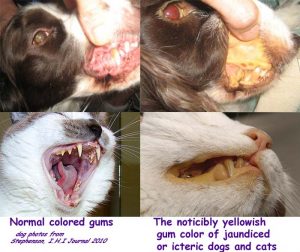Ron Hines DVM PhD



Jaundice describes the condition when your dog or cat‘s skin becomes abnormally yellowish. It is also called icterus, and it occurs when too much bilirubin is present in your pet’s blood stream. It is that bilirubin that gives your pet’s eyes, skin and mouth that abnormal yellowish color you see in the photos above.
So jaundice really represents the same thing as elevated blood bilirubin (hyperbilirubinemia) – one does not occur without the other. Jaundice is a sign that an underlying health problem exists – it is not a disease in itself.
Every day, a small number of red blood cells in your pet’s body naturally die, and are replaced by new ones. It is the job of your pet’s spleen to removes those spent RBCs and convert portions of their hemoglobin molecules into bilirubin. Once formed, this initial bilirubin (= pre hepatic bilirubin, unconjugated bilirubin, indirect bilirubin, insoluble bilirubin) teams up with the albumin protein protein in your pet’s blood stream and heads for the liver where it is further processed to post hepatic bilirubin (aka: conjugated bilirubin, direct bilirubin, soluble bilirubin).
Once formed, the great majority of bilirubin is excreted into your pet’s intestine in its bile. Much is later reabsorbed and re-excreted in an endless, repeating cycle. The portion that is not, is what gives some of the brownish color to the pet’s stools. When the amount of hemoglobin entering this cycle is excessive (as when abnormally large amount of red blood cells are destroyed within your pet’s body), when the liver is too damaged to excrete bilirubin into the bile or when the gall bladder or bile ducts to the intestine are plugged, your pets blood bilirubin levels will rise, and your pet will turn yellow (when levels are sufficiently high).
Some Of The Causes Of Jaundice In Dogs And Cats
I mentioned the three causes of jaundice in the last paragraph – too much raw heme residue from too many destroyed red blood cells, a liver damaged to the point where it can no longer process the bilirubin/albumin complex that is arriving via the blood stream or some form of obstruction to bile leaving the body through the pet’s bile duct.
Hepatic Jaundice
The most common cause of jaundice in dogs is one or another form of liver disease. When those diseases appear suddenly, they are called acute hepatitis. When they are the result of longer standing problems they are called chronic hepatitis. When they have progressed to substantial scaring of the pet’s liver, they are called cirrhosis. Problems in this area are often fuzzy and not confined to a single organ. Chronic inflammations in this area can involved the liver, pancreas and small intestine all to some degree. This is especially true in cats with triaditis.
Some of these liver problems are infectious – like occasional cases of leptospirosis, toxoplasmosis or feline infectious peritonitis and feline leukemia in cats. Rare systemic fungus infections (e.g. coccidioidomycosis or histoplasmosis) can also cause jaundice in pets.
Cats that will not eat for any reason are quite susceptible to hepatic lipidosis and hepatic lipidosis can be the underlying cause of jaundice. Cats with over active thyroid glands, hyperthyroidism, have been reported to be more susceptible to the liver problems that underlie jaundice as well.
Others cases of jaundice result from adverse reactions to medications (such as acetaminophen (Tylenol™), anti-seizure medications like phenobarbital or primidone, high-end doses of metronidazole, methimazole or diazepam, sulfa and tetracycline antibiotics anticancer drugs, etc.) or exposure to toxic compounds (herbicides, fungicides, insecticides, rodent poisons, zinc, aflatoxins, poison mushrooms, blue-green algae, etc.). These are sometimes called compounds that have the potential to cause “xenobiotic hepatotoxicity”.
On rare occasion, pets can be born with a tendency to liver failure and jaundice. A well-known type occurs occasionally in Bedlington terriers. (read here) Another genetically linked problem, familial amyloidosis (shar-peis, beagles, foxhounds) can have a similar effect.
Obstructive Jaundice (post-hepatic jaundice)
The second most common cause of jaundice is obstruction or interference in the function of the system that conveys the bilirubin-containing bile from the liver to the intestine (the pet’s biliary tree). That can include gallstones, cholangiohepatitis, liver or pancreatic cancer in older pets.
In tropical/semitropical climates, a particular fluke or flatworm has been known to obstruct the bile ducts of cats. (read here)
Pre-hepatic Jaundice
The third most common cause of jaundice occurs when abnormally large numbers of red blood cells are destroyed in your pet’s circulatory system (intravascular hemolysis). As expected, those pets will probably be anemic as well, and it is quite common for their spleen to be enlarges because it is the spleen’s responsibility to trap damaged red blood cells. It is quite common for substantial amounts of urobilinogen to be present in the urine of these pets as well. Red blood cell destruction of this type (intravascular hemolysis) is commonly due to blood parasites or autoimmune diseases affecting the blood (autoimmune hemolytic anemia).
In rare instances, jaundice occurs after a poorly matched or mismatched blood transfusion or when a processed blood substitute (oxyglobin) is given to pets as a blood substitute.
What Are The Signs I Will See If My Pet Is Jaundiced?
Signs related to jaundice are all related to the yellow/brown color of bilirubin. Your pet may have other symptoms – but those will be from the underlying cause of blood loss, liver damage or bile duct obstruction – not the bilirubin itself.
Many pet owners first notice that the white portion of their pet’s eyes (the sclera) have begun to take a yellowish hue. Unpigmented portions of your pet’s gums will assume the same color; as will unpigmented skin. The inner surface of the ears – particularly in cats, can be a good place to discover this.
At the same time, your pet’s urine can becomes considerably darker in color due to increased amounts of urobilinogen and, in some forms of jaundice, the urine bilirubin that is present.
When less bilirubin-containing bile reaches your pet’s intestine, stool often becomes lighter in color (“clay colored stool”).
Much like a bruise or black eye, the skin color of jaundice can persist for a considerable period of time after your pet’s liver problems have resolved, and blood values have returned to normal (bilirubin colors all three).
Complementary tests:
It generally takes a group of tests and imaging examinations to tell the difference between hepatic (liver) and post-hepatic causes of jaundice. Results of blood work can suggest one form or the other – but they are rarely sufficient to be certain which has occurred.
CBC and blood chemistry panel (bilirubin will always high when pets are jaundiced), ALT is often very high, while albumin, BUN, cholesterol and glucose are often low – particularly when the problem is in your pet’s liver. A more extensive liver panel of tests that includes GGT and prothrombin time (PT) and bile acids because some bone abnormalities can raise AlkPhos and ALT (but GGT is liver-specific), X-rays, abdominal ultrasound, liver biopsy, blood clotting profile (i.e. prothrombin time, aPPT, bleeding time, platelet count), Icterus Index, palpation.
When the veterinarian is suspicious of pre-hepatic/blood destruction causes, microscopic slide examinations and PCR tests to detect blood parasites as well as tests to check for evidence of autoimmune diseases (Coombs test, ANA test, M:E ratio, etc.)
DxMe
You are on the Vetspace animal health website
Visiting the products that you see displayed on this website help pay the cost of keeping these articles on the Internet.


